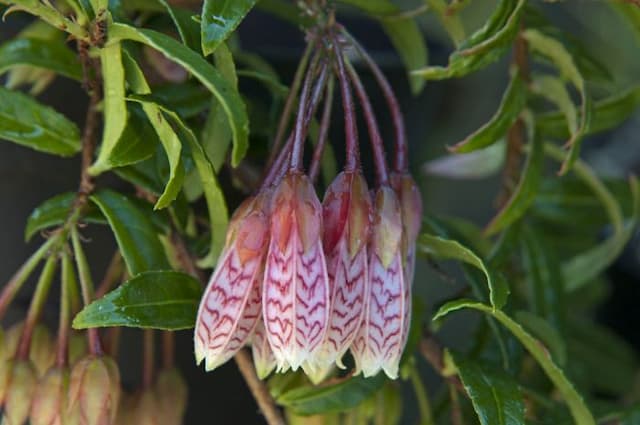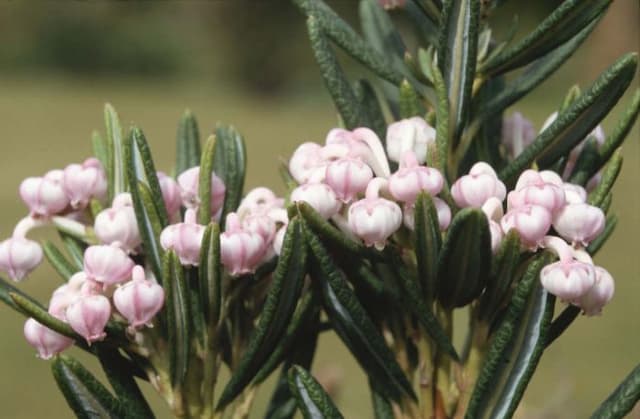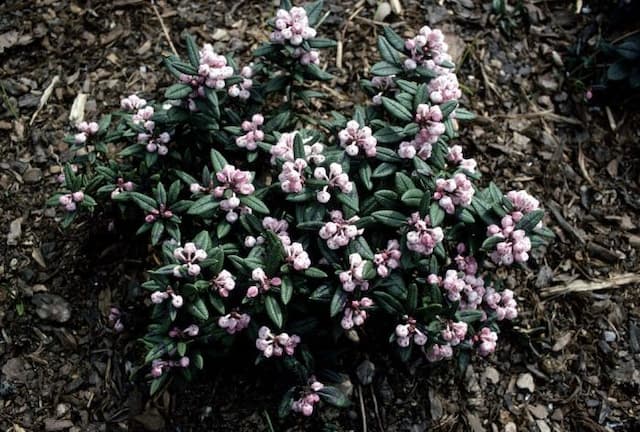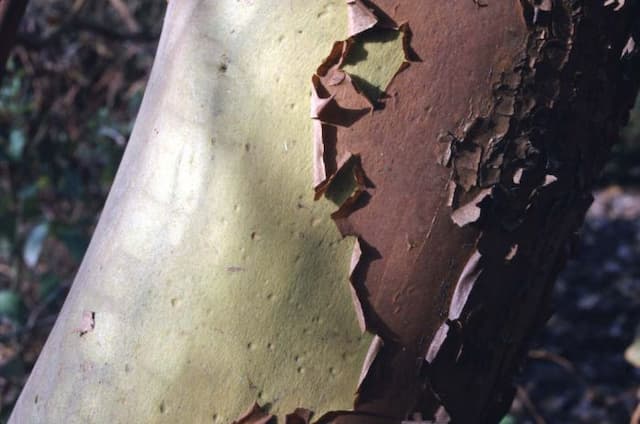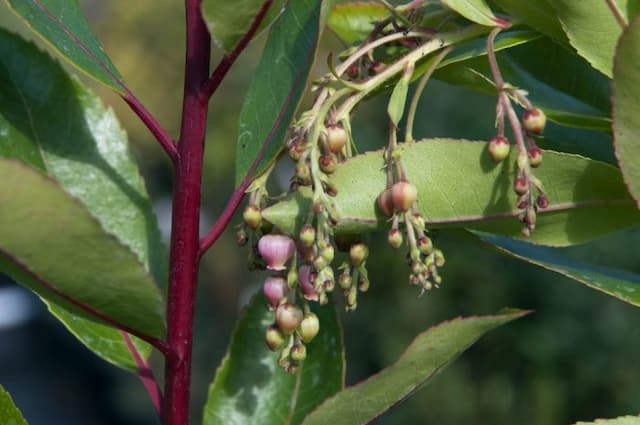Vuyk's Hybrid Azalea Rhododendron 'Beethoven' (Vuykiana) (EA)

ABOUT
The Rhododendron 'Beethoven' is a dazzling variety known for its spectacular floral display and ornamental foliage. The plant is comprised of evergreen leaves that present a glossy, dark green color, providing a year-round backdrop for its blooms. Its leaves have a smooth texture and are elliptically shaped, tapering to a point at the tip. The most striking feature of the Rhododendron 'Beethoven' is its flowers, which are large and showy. These blooms come in clusters, known as trusses, and exhibit a vibrant pink to purplish-pink hue. The flowers are funnel-shaped, with wavy edges that add to their ornate appearance. Each flower cluster creates a dramatic and colorful impact when the plant is in full bloom. The overall impression of the Rhododendron 'Beethoven' is one of lushness and vibrant color, with a great deal of visual appeal thanks to the combination of its elegant foliage and the flamboyant floral display that emerges prominently during the blooming season. This makes it a popular choice for gardens and landscapes where a touch of vivid color and evergreen presence is desired.
About this plant
 Names
NamesFamily
Ericaceae.
Synonyms
Beethoven Rhododendron, Vuykiana Rhododendron.
Common names
Rhododendron 'Beethoven'
 Toxicity
ToxicityTo humans
Rhododendrons, including Rhododendron 'Beethoven', contain toxic compounds that can be harmful to humans if ingested. The plant contains grayanotoxins, which can interfere with sodium channels affecting skeletal and cardiac muscle, as well as nerve function. Symptoms of poisoning from rhododendrons may include vomiting, diarrhea, hypersalivation, weakness, coma, hypotension, CNS depression, cardiovascular collapse, and potentially death if ingested in large enough quantities. It is important to seek medical attention immediately if ingestion is suspected.
To pets
Rhododendrons are toxic to pets such as dogs and cats. The toxic principle in these plants is grayanotoxin, which can affect the cardiac and skeletal muscles, as well as nerve function when ingested. Signs of rhododendron poisoning in pets can include vomiting, diarrhea, drooling, weakness, collapse, seizures, coma, and potentially death. It is crucial to contact a veterinarian immediately if a pet is suspected to have ingested any part of a rhododendron plant.
 Characteristics
CharacteristicsLife cycle
Perennials
Foliage type
Evergreen
Color of leaves
Green
Flower color
Pink
Height
5 feet (1.52 meters)
Spread
5 feet (1.52 meters)
Plant type
Shrub
Hardiness zones
5
Native area
Asia
Benefits
 General Benefits
General Benefits- Aesthetic Appeal: Rhododendron 'Beethoven' provides colorful blooms that enhance the beauty of gardens and landscapes.
- Habitat for Wildlife: The flowers can attract pollinators like bees and butterflies, providing them with nectar.
- Seasonal Interest: It offers spring interest with its bright flowers and evergreen leaves, which add to a garden's seasonal variation.
- Erosion Control: The plant's root system can help stabilize soil and prevent erosion on slopes.
- Privacy and Screening: When planted in groups, Rhododendron 'Beethoven' can create a dense hedge for privacy or as a windbreak.
- Low Maintenance: Once established, it requires minimal care, making it suitable for gardeners of all skill levels.
 Medical Properties
Medical PropertiesThis plant is not used for medical purposes.
 Air-purifying Qualities
Air-purifying QualitiesThis plant is not specifically known for air purifying qualities.
 Other Uses
Other Uses- Artistic Inspiration: Rhododendron artists often use the 'Beethoven' variety as a subject in botanical illustrations and garden landscapes due to its striking bloom.
- Natural Dye: The flowers and leaves of the rhododendron can sometimes be used to produce natural dyes for fabrics or artwork, offering a range of colors from yellows to greens.
- Educational Tool: Botany and horticulture teachers may use rhododendrons to help students learn about plant genetics, hybridization, and the impact of soil pH on flower color.
- Garden Design Learning: This specific variety's growth patterns and aesthetic qualities can be used as a case study for landscape design students.
- Privacy Screening: When planted in a row or a dense cluster, the rhododendron can function as a natural privacy screen for gardens and outdoor spaces.
- Culinary Decoration: Although the plant is toxic and not edible, rhododendron petals, specifically from 'Beethoven', could potentially be used as non-consumable decorations on cakes and pastries for special occasions.
- Photography: The vibrant blooms provide an excellent opportunity for photographers to practice macro and nature photography, capturing the intricacy of the rhododendron flowers.
- Insect Habitat: Rhododendrons, including 'Beethoven', can offer shelter and breeding grounds for beneficial garden insects, which in turn aid in pollination.
- Festival Decor: In regions where rhododendrons are celebrated, the 'Beethoven' variety might be used in parades and festival decorations for its showy appearance.
- Companion Planting: Savvy gardeners plant rhododendron 'Beethoven' with other species to create symbiotic relationships that benefit other plants by providing shade or improving soil conditions with fallen leaves.
Interesting Facts
 Feng Shui
Feng ShuiThe Rhododendron is not used in Feng Shui practice.
 Zodiac Sign Compitability
Zodiac Sign CompitabilityThe Rhododendron is not used in astrology practice.
 Plant Symbolism
Plant Symbolism- Beware: Rhododendrons, in general, are known to be toxic if ingested, symbolizing caution or a warning to be wary.
- Elegance: The 'Beethoven' rhododendron, with its beautiful flowers, is often associated with sophistication and elegance.
- Abundance: With its prolific blooms, the rhododendron can symbolize abundance and wealth.
- Passion: The vivid colors of the 'Beethoven' rhododendron can represent the intensity of passion and love.
- Homecoming: In some cultures, rhododendrons symbolize coming home or a wish for a safe return.
 Water
WaterRhododendrons, such as the 'Beethoven,' require consistent moisture and should be watered thoroughly when the top inch of soil feels dry, which is typically once a week. During periods of drought or extreme heat, they may need water twice a week, receiving about 1 gallon of water each time for a medium-sized shrub. It is vital to avoid overhead watering to prevent disease; instead, water directly at the base of the plant, soaking the root zone. During the winter, reduce watering but do not allow the roots to dry out completely. The goal is to maintain evenly moist soil without waterlogging the plant.
 Light
LightRhododendrons like 'Beethoven' thrive best in dappled shade or filtered light conditions. Avoid placing them in full sun, as this can lead to leaf scorch. An ideal spot would be under the canopy of tall trees that provide protection from intense midday sun while allowing some morning light or lightly filtered afternoon sun to reach the plant.
 Temperature
TemperatureThe 'Beethoven' rhododendron does well in a range of temperatures and can tolerate minimum temperatures down to 0°F. Optimal growing conditions include daytime temperatures between 59°F and 70°F. These plants prefer a cooler climate and may not thrive in regions where temperatures consistently exceed 80°F.
 Pruning
PruningPrune the 'Beethoven' rhododendron to maintain shape and encourage bushy growth, cutting back just above a set of leaves. Pruning is best done soon after the blooming period ends, typically in late spring or early summer, to avoid removing next year's buds. Deadheading spent flowers can also promote a tidier appearance and may encourage more vigorous blooms the following year.
 Cleaning
CleaningAs needed
 Soil
SoilAzaleas, including the 'Beethoven' variety, require a well-draining, moisture-retentive soil with high organic content. A mix of 50% peat moss or coco coir with 40% pine bark and 10% perlite or coarse sand is ideal. They prefer acidic soil with a pH between 4.5 and 6.0.
 Repotting
RepottingAzaleas like 'Beethoven' should be repotted every 2 to 3 years or when the root system outgrows the current pot. Repotting is best done in late winter or early spring before new growth begins.
 Humidity & Misting
Humidity & MistingAzaleas, such as 'Beethoven', thrive in environments with high humidity levels, ideally between 50-60%. They benefit from a humid atmosphere, but good air circulation is also important to prevent disease.
 Suitable locations
Suitable locationsIndoor
Place 'Beethoven' azaleas in bright, indirect light, away from drafts.
Outdoor
Plant 'Beethoven' azaleas in partial shade with shelter from harsh sun.
Hardiness zone
5-8 USDA
 Life cycle
Life cycleRhododendron 'Beethoven' begins its life cycle when a seed germinates in moist, well-drained acidic soil. The seedling develops into a young plant with characteristic leathery leaves and begins to establish a root system. As it matures, this evergreen shrub undergoes vegetative growth, producing sturdy branches and dense foliage. The Rhododendron 'Beethoven' reaches reproductive maturity in a few years, forming distinctive buds that bloom into large, showy flowers, typically in the spring. After pollination, possibly by bees or other insects, the plant produces seed capsules that, when mature, release seeds to start a new generation. The plant continues to grow and can live for many years, with the cycle of flowering and seed production repeating annually.
 Propogation
PropogationPropogation time
Spring to early summer
The Rhododendron 'Beethoven', which is a Vuykiana hybrid, commonly propagates through the process of semi-hardwood cuttings. This popular method typically takes place during the late summer. To propagate, a gardener would select a healthy, semi-hardwood stem from the current year's growth, ensuring that the cutting is approximately 4 to 6 inches (10 to 15 centimeters) long. Leaves on the lower half of the cutting are removed, and the cut end is dipped into a rooting hormone powder or gel to encourage root development. Then, the cutting is inserted into a mix of peat and perlite or a similar well-draining medium. The environment should be kept humid by covering the cutting with a plastic bag or dome and placed in indirect light. Roots usually develop within a few weeks, after which the new Rhododendron 'Beethoven' plant can be transplanted.
